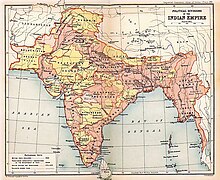Modern India
Historians consider India's modern age to have begun sometime between 1848 and 1885. The appointment in 1848 of Lord Dalhousie as Governor General of the East India Company set the stage for changes essential to a modern state. These included the consolidation and demarcation of sovereignty, the surveillance of the population, and the education of citizens. Technological changes—among them, railways, canals, and the telegraph—were introduced not long after their introduction in Europe.[83][84][85][86] However, disaffection with the Company also grew during this time, and set off the Indian Rebellion of 1857. Fed by diverse resentments and perceptions, including invasive British-style social reforms, harsh land taxes, and summary treatment of some rich landowners and princes, the rebellion rocked many regions of northern and central India and shook the foundations of Company rule.[87][88] Although the rebellion was suppressed by 1858, it led to the dissolution of the East India Company and to the direct administration of India by the British government. Proclaiming a unitary state and a gradual but limited British-style parliamentary system, the new rulers also protected princes and landed gentry as a feudal safeguard against future unrest.[89][90] In the decades following, public life gradually emerged all over India, leading eventually to the founding of the Indian National Congress in 1885.[91][92][93][94]
The rush of technology and the commercialisation of agriculture in the second half of the 19th century was marked by economic setbacks—many small farmers became dependent on the whims of far-away markets.[95] There was an increase in the number of large-scale famines,[96] and, despite the risks of infrastructure development borne by Indian taxpayers, little industrial employment was generated for Indians.[97] There were also salutary effects: commercial cropping, especially in the newly canalled Punjab, led to increased food production for internal consumption.[98] The railway network provided critical famine relief,[99] notably reduced the cost of moving goods,[99] and helped nascent Indian-owned industry.[98] After World War I, in which some one million Indians served,[100] a new period began. It was marked by British reforms but also repressive legislation, by more strident Indian calls for self-rule, and by the beginnings of a non-violent movement of non-cooperation, of which Mohandas Karamchand Gandhi would become the leader and enduring symbol.[101] During the 1930s, slow legislative reform was enacted by the British; the Indian National Congress won victories in the resulting elections.[102] The next decade was beset with crises: Indian participation in World War II, the Congress's final push for non-cooperation, and an upsurge of Muslim nationalism. All were capped by the advent of independence in 1947, but tempered by the partition of India into two states: India and Pakistan.[103]
Vital to India's self-image as an independent nation was its constitution, completed in 1950, which put in place a secular and democratic republic.[104] In the 60 years since, India has had a mixed record of successes and failures.[105] It has remained a democracy with civil liberties, an activist Supreme Court, and a largely independent press.[105] Economic liberalisation, which was begun in the 1990s, has created a large urban middle class, transformed India into one of the world's fastest-growing economies,[106] and increased its geopolitical clout. Indian movies, music, and spiritual teachings play an increasing role in global culture.[105] Yet, India has also been weighed down by seemingly unyielding poverty, both rural and urban;[105] by religious and caste-related violence;[107] by Maoist-inspired Naxalite insurgencies;[108] and by separatism in Jammu and Kashmir and in Northeast India.[109] It has unresolved territorial disputes with China,[110] and withPakistan.[110] The India–Pakistan nuclear rivalry came to a head in 1998.[111] India's sustained democratic freedoms are unique among the world's new nations; however, in spite of its recent economic successes, freedom from want for its disadvantaged population remains a goal yet to be achieved.[112]

कोई टिप्पणी नहीं:
एक टिप्पणी भेजें